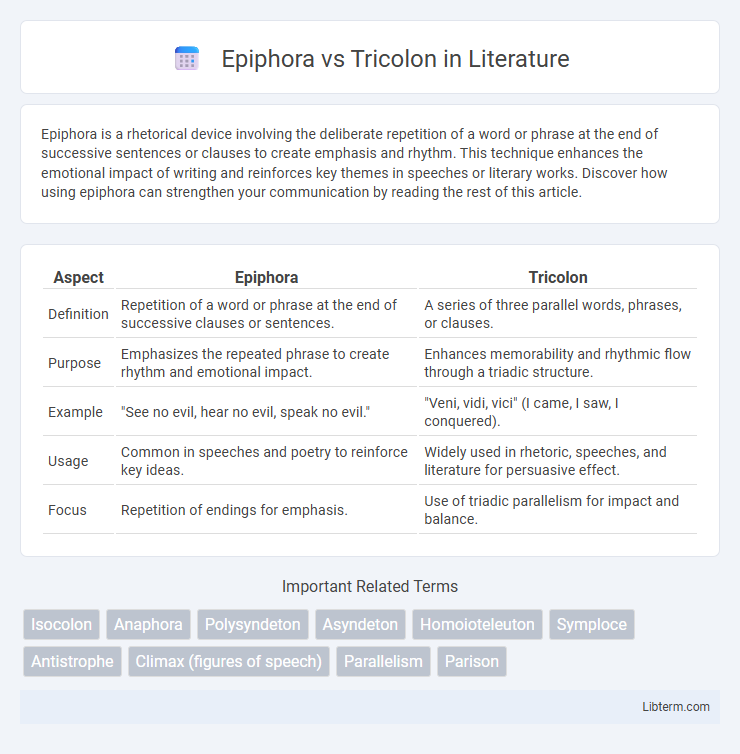Epiphora is a rhetorical device involving the deliberate repetition of a word or phrase at the end of successive sentences or clauses to create emphasis and rhythm. This technique enhances the emotional impact of writing and reinforces key themes in speeches or literary works. Discover how using epiphora can strengthen your communication by reading the rest of this article.
Table of Comparison
| Aspect | Epiphora | Tricolon |
|---|---|---|
| Definition | Repetition of a word or phrase at the end of successive clauses or sentences. | A series of three parallel words, phrases, or clauses. |
| Purpose | Emphasizes the repeated phrase to create rhythm and emotional impact. | Enhances memorability and rhythmic flow through a triadic structure. |
| Example | "See no evil, hear no evil, speak no evil." | "Veni, vidi, vici" (I came, I saw, I conquered). |
| Usage | Common in speeches and poetry to reinforce key ideas. | Widely used in rhetoric, speeches, and literature for persuasive effect. |
| Focus | Repetition of endings for emphasis. | Use of triadic parallelism for impact and balance. |
Introduction to Epiphora and Tricolon
Epiphora is a rhetorical device characterized by the repetition of a word or phrase at the end of successive clauses or sentences, enhancing emphasis and emotional impact. Tricolon consists of three parallel elements or phrases of similar length arranged in a series, creating a memorable and rhythmic effect. Both techniques are widely used in speeches and literature to reinforce key ideas and persuade audiences effectively.
Defining Epiphora: Meaning and Purpose
Epiphora is a rhetorical device characterized by the deliberate repetition of a word or phrase at the end of successive clauses or sentences, enhancing emphasis and emotional impact. It serves to reinforce a point and create a memorable rhythm in speech or writing. Unlike tricolon, which involves grouping ideas into three parts for balanced structure, epiphora highlights the power of recurring concluding words to influence the audience.
Understanding the Tricolon Structure
Epiphora and tricolon are distinct rhetorical devices, with epiphora involving the repetition of a word or phrase at the end of successive clauses, while tricolon refers to a series of three parallel elements or phrases that create rhythm and emphasis. Understanding the tricolon structure hinges on recognizing its three-part parallelism, which enhances clarity and persuasiveness through balanced and memorable phrasing. This technique is frequently used in speeches and literature to build momentum and reinforce key points effectively.
Key Differences Between Epiphora and Tricolon
Epiphora involves the repetition of a word or phrase at the end of successive clauses or sentences, emphasizing a specific idea or emotion, while tricolon is a stylistic device consisting of three parallel elements, phrases, or clauses, often balanced for rhythm and impact. Epiphora creates emphasis through repetition for persuasive or poetic effect, whereas tricolon builds intensity and memorability through a structured, three-part list. Understanding these distinctions clarifies their unique rhetorical functions in speech and writing.
Semantic Impact in Rhetorical Devices
Epiphora, the repetition of a word or phrase at the end of successive clauses, creates strong emphasis and emotional resonance by reinforcing key ideas, making messages more memorable and persuasive. Tricolon, a series of three parallel elements, leverages rhythmic balance and escalation to enhance clarity and impact, often driving points home with a sense of completeness and power. Both rhetorical devices optimize semantic effect, but epiphora intensifies focus on repeated concepts while tricolon emphasizes structured progression and pattern recognition.
Famous Examples of Epiphora in Literature
Epiphora, characterized by the repetition of a word or phrase at the end of successive clauses, contrasts with tricolon, which structures ideas in three parallel elements for rhythmic impact. Famous examples of epiphora in literature include Charles Dickens' *A Tale of Two Cities* with the memorable line "It was the best of times, it was the worst of times...," emphasizing "times" to evoke contrast and emotion. Another notable instance is Abraham Lincoln's Gettysburg Address, where he repeats "of the people, by the people, for the people" to underscore the democratic ideals of governance.
Notable Uses of Tricolon in Speeches
Tricolon, a rhetorical device consisting of three parallel elements, enhances memorability and emphasis in speeches, as famously used by Julius Caesar in "Veni, vidi, vici." Notable speeches, including Martin Luther King Jr.'s "I Have a Dream," employ tricolon to create rhythm and reinforce key messages. Unlike epiphora, which repeats words at the end of clauses, tricolon builds persuasive impact through structured triplets of ideas.
Effectiveness in Persuasive Writing
Epiphora, the repetition of a word or phrase at the end of successive clauses, intensifies emphasis and creates a memorable rhythm that reinforces the message in persuasive writing. Tricolon, a series of three parallel elements, enhances persuasion by providing a balanced, rhythmic structure that increases readability and impact. Both devices are highly effective in reinforcing key points, but epiphora drives emotional appeal, while tricolon strengthens logical progression.
How to Use Epiphora and Tricolon Effectively
Epiphora and tricolon enhance writing by emphasizing key points through repetition and parallel structure, respectively. To use epiphora effectively, repeat the same word or phrase at the end of successive sentences to create a memorable rhythm and reinforce a central idea. Employ tricolon by grouping three parallel elements or phrases to build momentum and make arguments or statements more persuasive and impactful.
Epiphora vs Tricolon: Summary and Conclusion
Epiphora and tricolon both enhance rhetoric but serve different purposes: epiphora emphasizes repetition of words or phrases at the end of consecutive clauses, creating a rhythmic and memorable impact, while tricolon involves a series of three parallel elements that build intensity and balance in speech or writing. Epiphora's strength lies in reinforcing a key idea through repetition, making it particularly effective in emotional appeals and persuasive contexts. Tricolon achieves a sense of completeness and emphasis through its structured tripartite form, ideal for highlighting important points with clarity and power.
Epiphora Infographic

 libterm.com
libterm.com